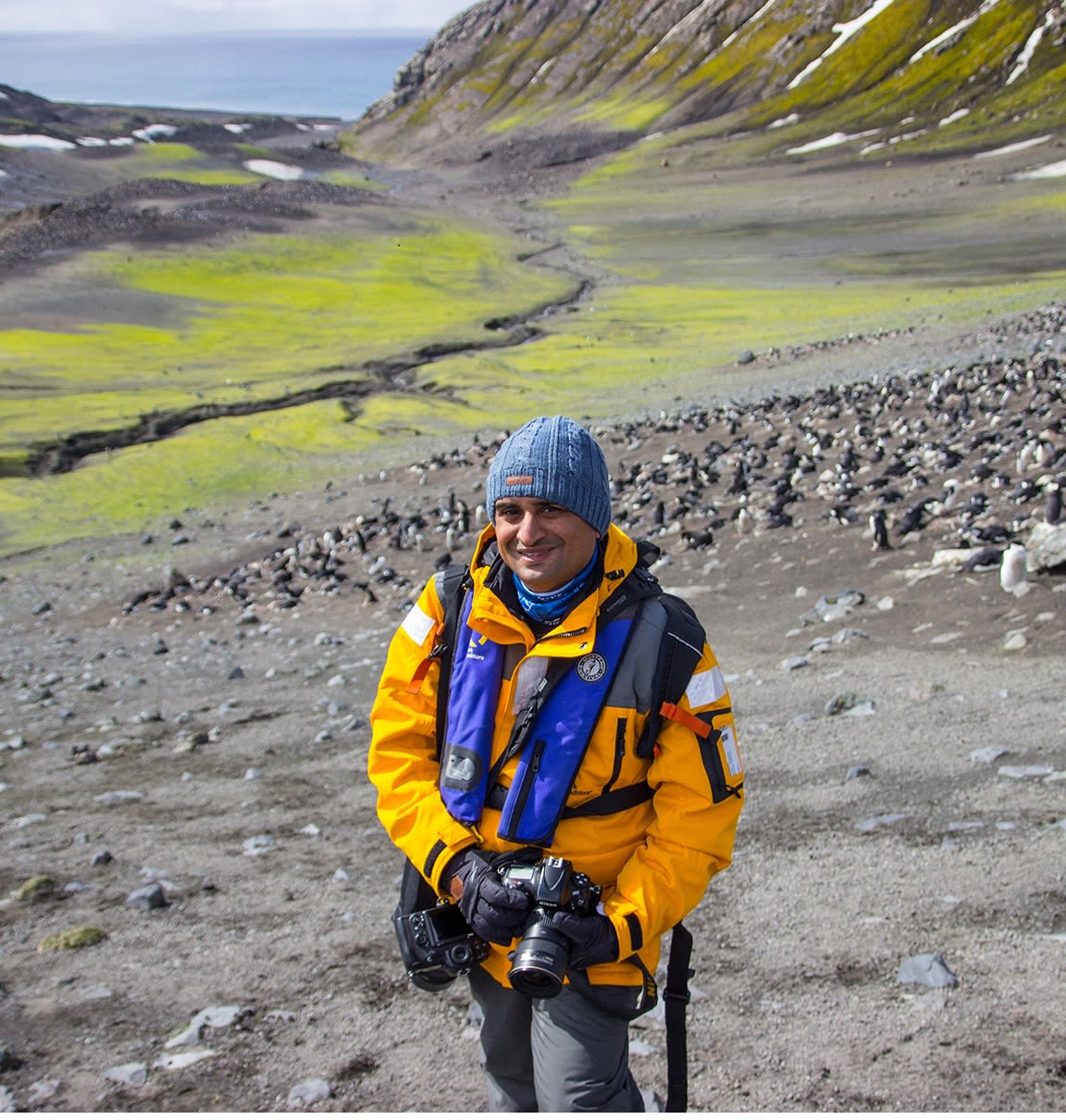Crabs are hard to miss on India’s coasts. They scuttle away from under your feet as you walk on the beach. They wait on rocks by the sea, braving the waves that crash into them and live and swim in mangrove streams. They are important to local fishers and served as delicacies at local restaurants.
Originating in the early Jurassic period (200 million years ago), crabs have come a long way, evolving into various forms that occupy several ecological niches. Crabs belong to the order Brachyura. On the Konkan coast of Western India, there are numerous species, ranging in size from tiny pea crabs to massive mud crabs. Thirty species, belonging to 24 genera from 8 families, were recorded by Pradnya D Bandekar and VS Kakati around Karwar in North Karnataka in a study published in the Indian Journal of Ecology in 2020. This incredible diversity stems from the variety of habitats along the coast that different crabs have adapted to, ranging from sandy beaches to intertidal zones, mangroves, and rocks. Food preferences also play an important role in creating diversity; some crabs hunt small prey, some filter nutrients from the sand, some are herbivores, and others are parasites.
Crabs have a significant impact on mangroves. They act as nutrient recycling systems by feeding on leaves and litter. Their constant digging activity aerates the tightly packed mangrove soil. And they are an important prey base for many predators.
The health of our coastal ecosystems has a direct impact on the lives of crabs. As human activity increases along our coast, there is a greater threat to the amazing diversity of Konkan coast crabs. These threats include habitat degradation, heightened disturbance from the rise in footfall, and other human-associated threats like free-ranging stray dogs. Here are some of the crabs you’re likely to come across on a stroll along this coast.
Come dusk, and the beach starts getting crowded. When the humans disperse after sunset, horned ghost crabs (Ocypode ceratophthalma) emerge from their burrows and scuttle around on the water’s edge. They are among the fastest runners in the brachyuran (crab) world, clocking speeds of up to 2.1 metres/second (study by Burrows and Hoyle, 1973). Being generalist feeders, they hunt small prey and scavenge opportunistically. Larger individuals have also been recorded feeding on turtle hatchlings. This crab’s common name is derived from the stalks over the eyes (right) — a distinctive feature of some Ocypode species. One claw is slightly larger than the other but not as remarkable as male fiddler crabs of the same family. They wet their gills periodically by submerging themselves in incoming waves or by absorbing water from wet sand. Only when their gills are moist can they breathe air on land. This species has the widest distribution among all ghost crabs (subfamily Ocypodiane), ranging from the coast of East Africa through Asia and to Australia. Ghost crab burrows are often studied to understand the anthropomorphic (human) impact on beaches worldwide.
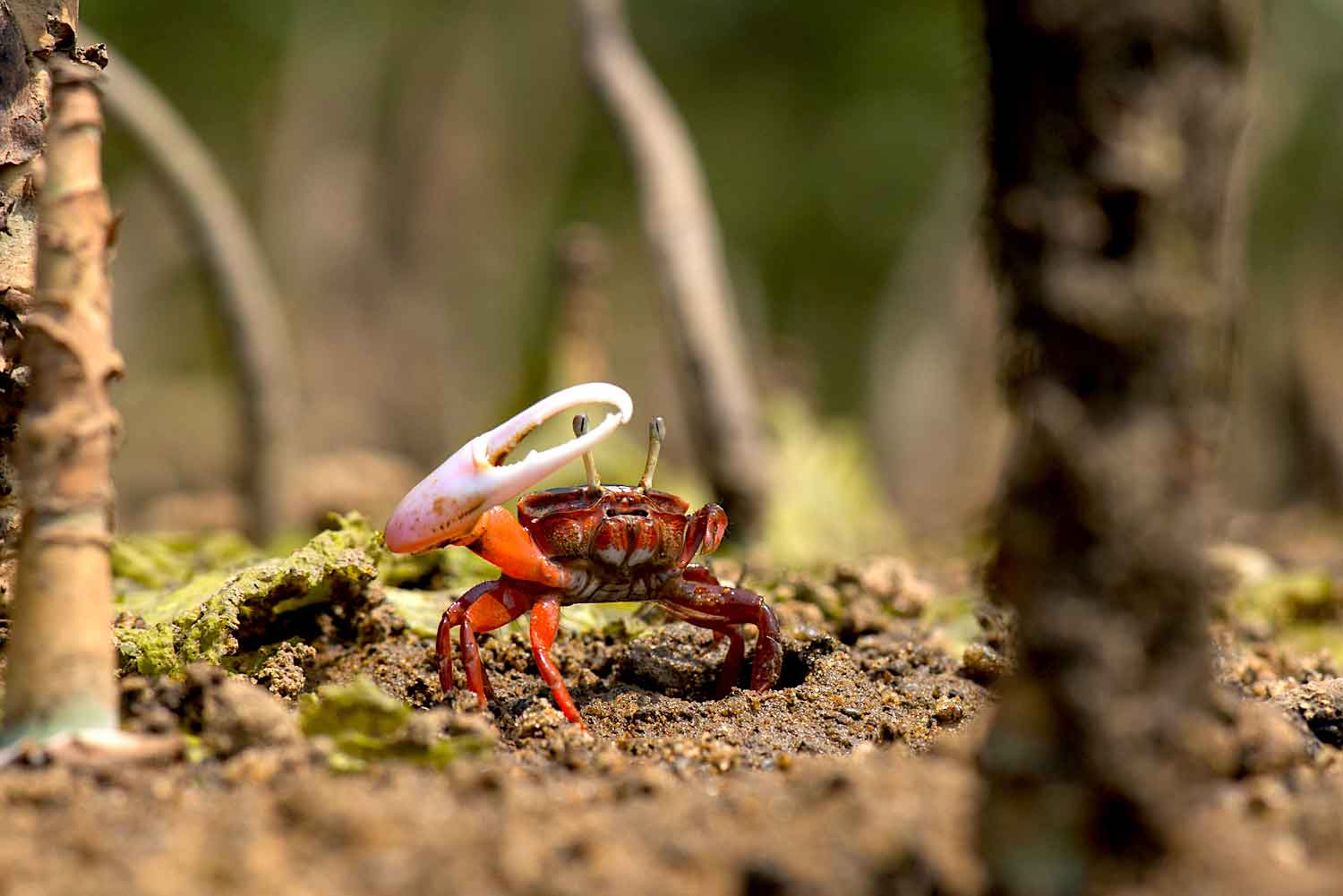
Standing amidst a colony of fiddler crabs (Austruca annulipes) feels like being on a miniature battlefield. These tiny crabs measure just over an inch in size. Males have one large claw (chela). They wave this claw during courtship displays — the motion gives an impression of playing a fiddle, giving this group their common name. The claw is also used for feeding and in combat with other males. If this dominant claw is lost in a fight, it starts regrowing from the next moult. In some species, the remaining smaller claw grows larger while the lost claw regrows into a smaller one.
It is hard to miss these stunning patterns on a sandy beach (left). The architect lives in the centre of these tiny fortresses and makes its living out of sand art. Sand-bubbler crabs (Scopimera proxima) are tiny, with carapaces measuring about a centimetre. They stay in underground burrows within a bubble of air during high tide. As the water recedes, they surface and feed on organic matter filtered from the sand. After filtering, they discard sand pellets that form radial patterns around the burrow until the incoming tide washes over them.
(Top) Sometimes, you may see a huge living mass of grey and pink on the shore when the tide is out. These aptly named soldier crabs (Dotilla myctiroides) belong to the family of sand-bubbler crabs (Dotillidae). After they’ve had their fill from the wet sand, individuals start congregating in groups that grow larger and larger till the tide eventually comes back in. In a 2019 paper, C H Ramesh et al. published in the journal Emergent Life Sciences Research , they recorded “several thousands of D. myctiroides individuals within a 10 m2 exposed sandy beach area and occurred in densities of more than 500 per meter square area” on the southeast coast of India. (Above right) While there is safety in numbers, soldier crabs attract the attention of predators too. Birds like this common redshank (Tringa tetanus) and ghost crabs will often make the best of this buffet.
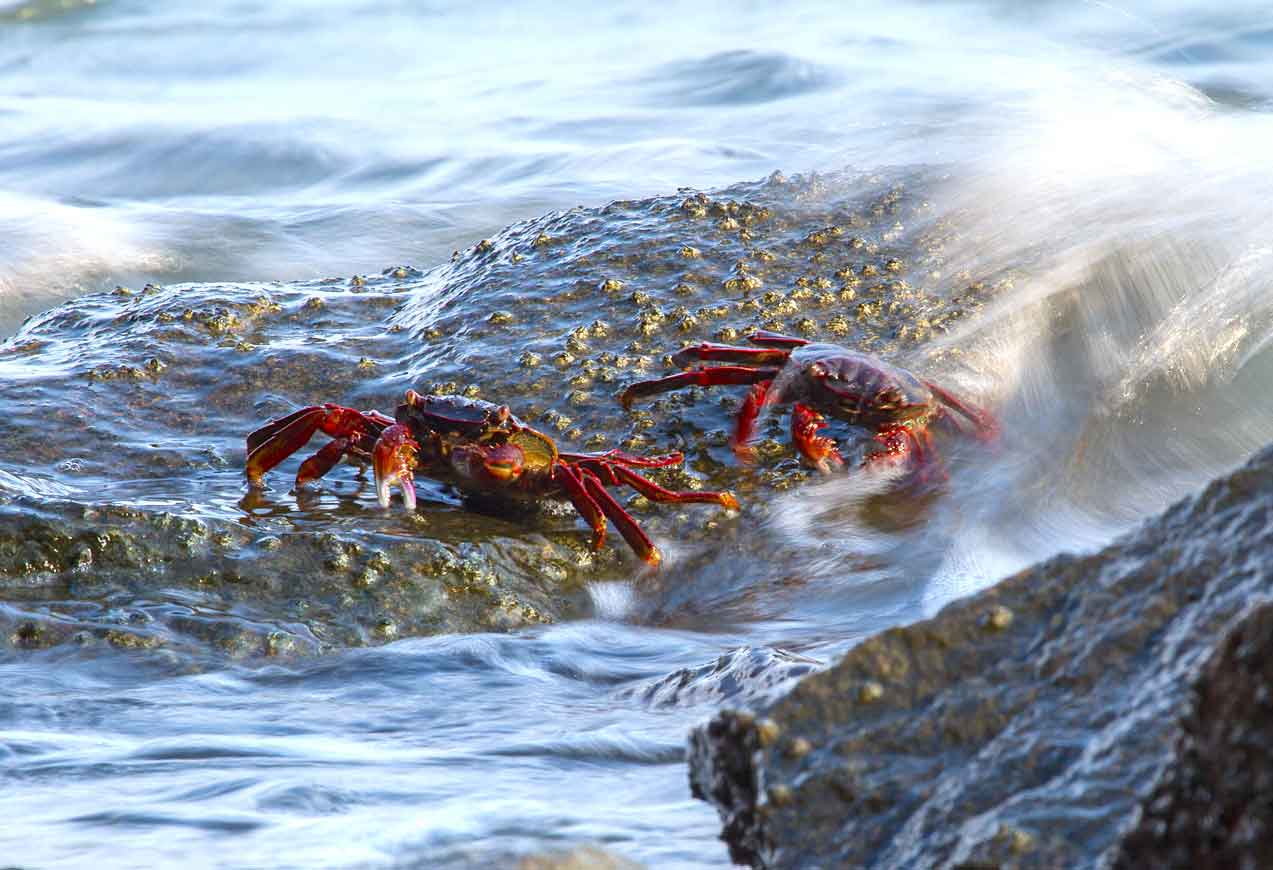
Imagine sitting on a reef and getting battered by strong waves every few seconds. Welcome to the world of the mottled or shore crab (Grapsus albolineatus) . This species is widely distributed across the world’s coasts, including East Africa, much of Asia, Australia, islands of the Pacific Ocean and Chile. On the Konkan coast, their carapace is greenish, and their legs are bright-red legs with white tips. These crabs sit in groups on rocks and reefs by the sea, disappearing into crevices or under rocks at the slightest disturbance. Algae on these rocks form the bulk of their diet, which sometimes also includes fish and other crustaceans.
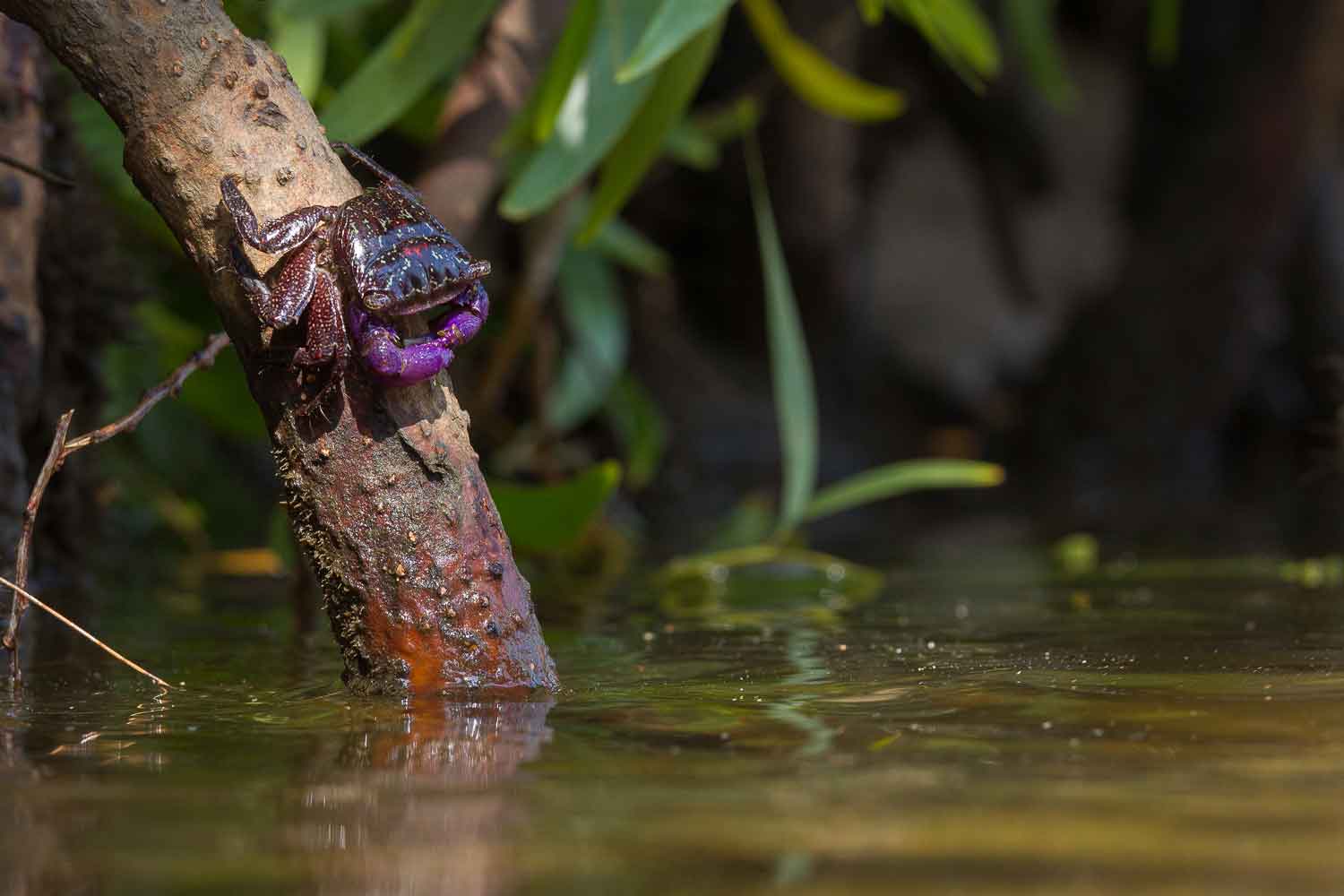
The purple-claw mudflat crab (Metopograpsus latifrons) is a bright purple crab found in the mangroves amidst the roots of Avicennia and Rhizophora trees. This species belongs to the same family (Grapsidae) as the mottled/shore crab and has a similar diet.
Unlike other crabs, diminutive pea crabs (Pinnotheres sp.) are not easy to find. In addition to being tiny, adults are parasites that live and feed inside bivalves (like mussels and oysters), sea cucumbers, and other marine creatures. Juveniles become part of the plankton community, moving freely in the sea.
The giant mud crab (Scylla serrata) is a swimming crab found all over the Indo-Pacific, from South Africa to New Zealand. It is the largest crab on the Konkan coast. Females can grow up to 24 centimetres (carapace length) and weigh as much as 3.5 kg. These crabs can be cannibalistic, with hard-shelled individuals devouring moulting ones. Their enormous chelae (claws) are strong enough to give a very painful pinch to an inexperienced hunter.
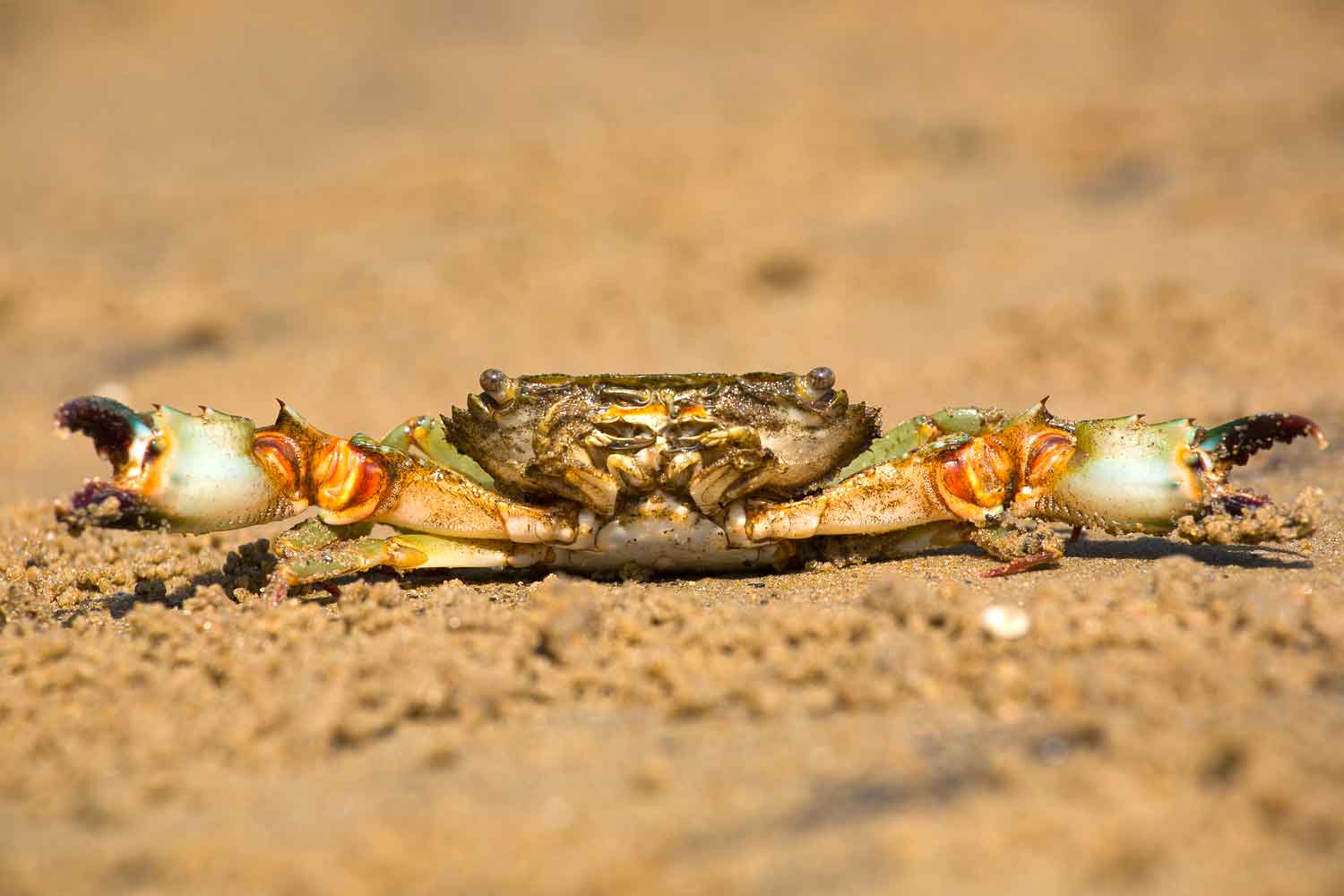
A mangrove swimming crab (Thalamita crenata) shows off its imposing claws as it slowly crawls back to safety. This species lives in the intertidal zones of mangroves, where it hunts bivalves and crustaceans underwater. The last pair of legs are flattened in this crab family (Portunidae) act as paddles that aid swimming. Along with the mud crab, this species is harvested for the table.
